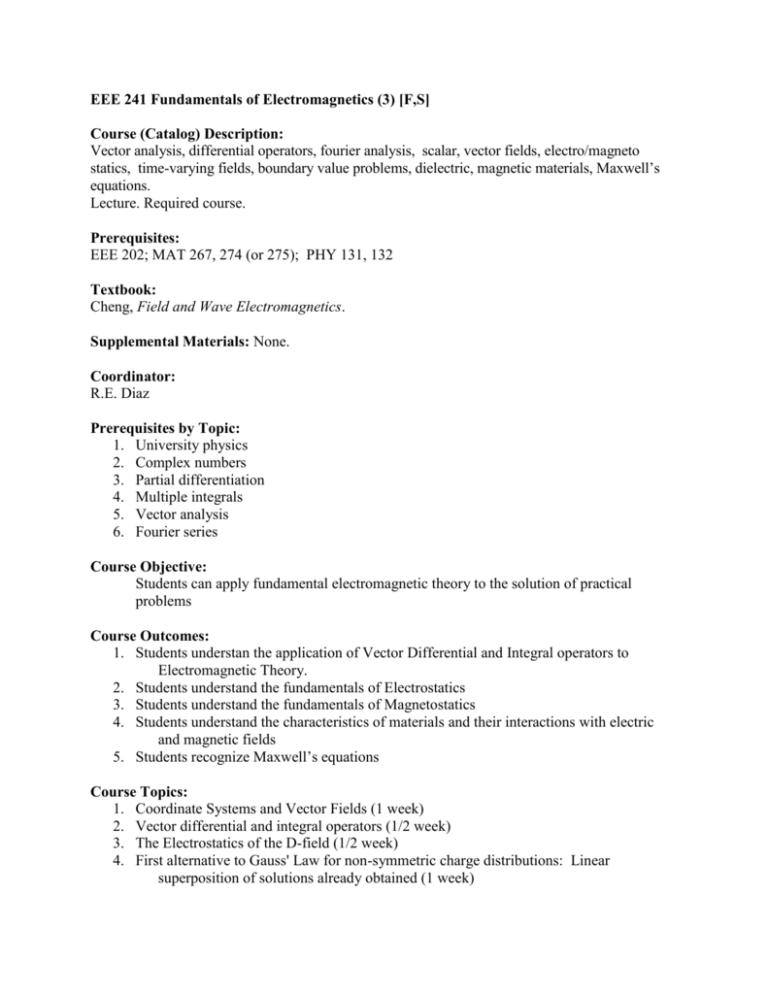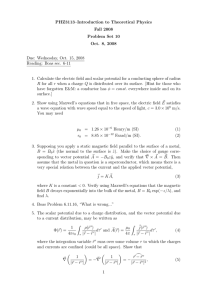EEE 241 Electromagnetics Course Syllabus
advertisement

EEE 241 Fundamentals of Electromagnetics (3) [F,S] Course (Catalog) Description: Vector analysis, differential operators, fourier analysis, scalar, vector fields, electro/magneto statics, time-varying fields, boundary value problems, dielectric, magnetic materials, Maxwell’s equations. Lecture. Required course. Prerequisites: EEE 202; MAT 267, 274 (or 275); PHY 131, 132 Textbook: Cheng, Field and Wave Electromagnetics. Supplemental Materials: None. Coordinator: R.E. Diaz Prerequisites by Topic: 1. University physics 2. Complex numbers 3. Partial differentiation 4. Multiple integrals 5. Vector analysis 6. Fourier series Course Objective: Students can apply fundamental electromagnetic theory to the solution of practical problems Course Outcomes: 1. Students understan the application of Vector Differential and Integral operators to Electromagnetic Theory. 2. Students understand the fundamentals of Electrostatics 3. Students understand the fundamentals of Magnetostatics 4. Students understand the characteristics of materials and their interactions with electric and magnetic fields 5. Students recognize Maxwell’s equations Course Topics: 1. Coordinate Systems and Vector Fields (1 week) 2. Vector differential and integral operators (1/2 week) 3. The Electrostatics of the D-field (1/2 week) 4. First alternative to Gauss' Law for non-symmetric charge distributions: Linear superposition of solutions already obtained (1 week) 5. Second alternative to Gauss' Law: Integration over sources to calculate the D-field of symmetric and non symmetric charge distributions (1week) 6. Third alternative to Gauss' Law: The potential function (1 week) 7. Boundary value problems I: Method of Images (1 week) 8. Boundary Value Problems II: Laplace's equation. (incl. Fourier Series Solution.) (1 week) 9. Capacitance (1/2 week) 10. Real (complex) materials: Dispersive permittivity (1/2 week) 11. The electromagnetic field of a moving charge and the concepts of Current and Magnetic field (1/2 week) 12. Maxwell's first Curl Equation aka Ampere's law (1/2 week) 13. Using Ampere's Law in integral form to obtain the magnetic fields of highly symmetric current distributions (1 week) 14. Second alternative to Ampere's Law, integration over current elements (1 week) 15. Third alternative to Ampere's law, the vector potential (1/2 week) 16. Force and energy in the magnetic field (1/2 week) 17. Inductance (1 week) 18. Maxwell's second Curl equation aka Faraday's Law (incl. EMI) (1 week) 19. Recap of Maxwell's equations (1 week) Computer Usage: Students use MATLAB or MathCAD to develop and visualize solutions to moderately complicated field problems. Laboratory Experiments: None. Course Contribution to Engineering Science and Design: This is a core course required of all EE majors. Electricity and magnetism is a necessary foundation for all subsequent courses in circuits, power, electromagnetics, and solid-state electronics. Course Relationship to Program Outcomes: Electricity and magnetism are necessary foundations of current critical technology such as wireless communication, biosensors, semiconductor devices, etc. Therefore this class contributes to both the breadth of knowledge and the technical competency objectives of our program. In addition, advanced mathematics, vector differential calculus and understanding solutions of differential equations are covered. All these fall under Outcome a. Moreover, modern software tools such as MATLAB and MathCAD are utilized (k) and the class also involves some modeling and general problem solving methodologies (e). Person preparing this description and date of preparation: R.E. Diaz, K. Tsakalis, Apr. 2009.











